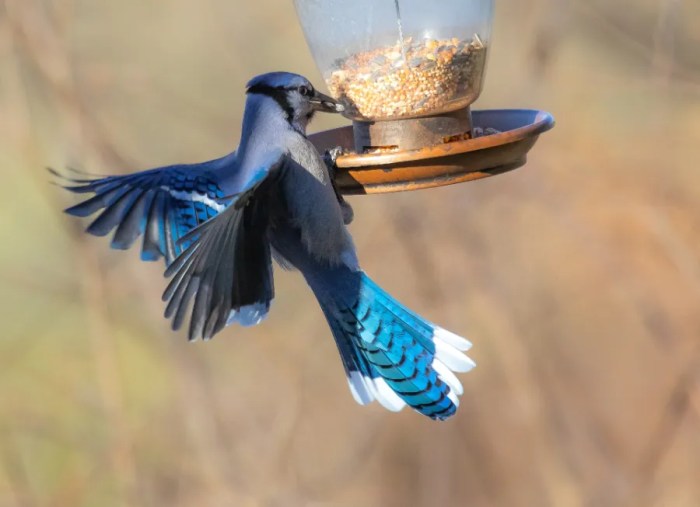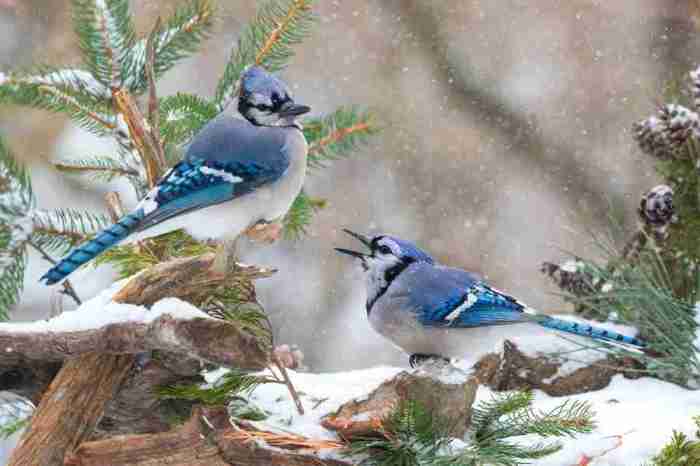Seed Viability After Caching: Do Blue Jays Plant Seeds In Containers

Do blue jays plant seeds in containers – Blue jays are renowned for their remarkable caching behavior, burying thousands of seeds each autumn to ensure a food supply for the leaner months. However, the success of this strategy hinges on the viability of these cached seeds. A multitude of factors influence whether a cached seed will germinate successfully, impacting the overall reproductive success of the plant species and the foraging efficiency of the jay itself.
Understanding these factors is crucial to comprehending the complex ecological interplay between blue jays and forest ecosystems.
Factors Affecting Seed Viability After Caching
Several environmental and biological factors interact to determine the fate of a cached seed. Seed viability, the ability of a seed to germinate and grow into a plant, is affected by factors like seed predation, microclimate conditions at the caching site, and the inherent characteristics of the seed itself. For instance, some seeds possess a natural dormancy period, requiring specific environmental cues like temperature or moisture levels to break dormancy and initiate germination.
While blue jays don’t typically plant seeds in containers in the way humans do, their caching behavior might be considered a form of natural seed dispersal. Thinking about controlled environments, it’s interesting to contrast this with the curated aesthetic of an artificial plant, such as this lovely olive tree artificial plant , which offers a sense of permanence and control absent in the unpredictable world of blue jay seed dispersal.
Ultimately, both scenarios reflect different approaches to managing growth and life cycles.
The length of time a seed remains cached, along with the presence of microbial activity and oxygen availability within the soil, also significantly influence its survival. Furthermore, the quality of the seed itself, prior to caching, plays a crucial role. A seed already damaged or of low quality is less likely to germinate, regardless of ideal caching conditions.
Examples of Successfully Germinated Cached Seeds
Many studies have documented the successful germination of seeds cached by blue jays. Oak acorns, for example, are a common cache item, and many successfully germinate after being buried. Similarly, beechnuts, which possess a relatively hard shell providing some protection, also demonstrate a reasonable germination rate post-caching. The success of these seeds is partly attributed to their inherent resilience and the ability of the blue jay to select high-quality seeds for caching.
Other species such as various nuts and seeds from shrubs and trees have also been shown to exhibit post-caching germination, though the rates vary widely depending on the species and the caching conditions.
Impact of Caching Location on Seed Survival Rates
The location of the cache significantly impacts seed survival. Caches buried in well-drained soil, with appropriate moisture levels and protection from extreme temperature fluctuations, are more likely to yield successful germination. Conversely, caches located in areas prone to flooding, extreme drought, or intense sunlight often experience reduced germination rates. The proximity to other seeds or competing vegetation can also affect the success of a cached seed, as competition for resources like water and nutrients can hinder germination and seedling establishment.
Moreover, the depth of the cache plays a vital role; seeds buried too deeply may lack sufficient oxygen or light, while those buried too shallowly may be susceptible to desiccation or predation.
Hypothetical Experiment: Germination Rates of Cached vs. Uncached Seeds
A controlled experiment could directly compare the germination rates of seeds cached by blue jays versus seeds that were not cached. Two groups of seeds of the same species and quality would be used. One group would be subjected to simulated caching conditions: buried at various depths in controlled soil environments mirroring typical jay caching sites. The other group would be maintained under laboratory conditions optimal for germination, serving as a control group.
Germination rates would be monitored and compared over a defined period, accounting for variables like soil moisture, temperature, and light exposure. This experiment could provide quantitative data to support observations on the impact of caching on seed viability, potentially revealing the success rate of blue jay caching as a seed dispersal mechanism.
Blue Jay Habitat and Seed Sources

Blue jays, known for their intelligence and remarkable caching behavior, inhabit a variety of ecosystems across North America. Understanding their habitat preferences and the types of seeds they collect is crucial to comprehending their ecological role and the impact they have on forest regeneration. Their seed-caching habits contribute significantly to the dispersal and establishment of various plant species.
The habitats favored by blue jays are primarily characterized by the presence of mature trees, providing ample foraging opportunities and nesting sites. These habitats offer a diverse array of seed sources, influencing the types of seeds cached and the overall success of seed dispersal. The availability of these seed sources varies seasonally, impacting the blue jay’s caching strategies throughout the year.
Blue Jay Habitat Preferences
Blue jays are highly adaptable birds, found in a range of habitats, from deciduous and mixed forests to woodlands, parks, and even suburban areas with ample tree cover. They show a preference for areas with a dense understory, offering protection from predators and readily available food sources. Mature forests, particularly those with oak and pine trees, are particularly attractive due to the abundance of acorns and other seeds.
Proximity to water sources is also a factor influencing habitat selection. In more urban environments, blue jays thrive in areas with large, established trees providing both food and shelter.
Commonly Cached Seed Types
The seeds cached by blue jays reflect the diversity of plant life in their habitats. Acorns from oak trees are a staple food source, comprising a significant portion of their cached seeds. Other common seed types include those from pine trees (pine nuts), beech trees (beechnuts), and various shrubs and herbaceous plants. The types of seeds cached can vary geographically, depending on the local flora.
For example, areas with abundant hickory trees will see a higher proportion of hickory nuts cached compared to areas lacking these trees. This variation highlights the adaptability of the blue jay to its local environment.
Frequently Cached Plant Species, Do blue jays plant seeds in containers
The following list details plant species whose seeds are frequently cached by blue jays:
- Quercus spp. (Oaks): Acorns are a primary food source and are extensively cached.
- Pinus spp. (Pines): Pine nuts are another important seed type, especially in pine-dominated forests.
- Fagus grandifolia (American Beech): Beechnuts are a valuable food source, often cached in significant numbers.
- Carya spp. (Hickories): Hickory nuts are also frequently cached, contributing to the dispersal of these trees.
- Cornus spp. (Dogwoods): Various dogwood species produce berries with seeds that blue jays consume and cache.
- Viburnum spp. (Viburnums): The berries of viburnums are another source of seeds that are cached.
The abundance of these plants in a given area directly influences the caching behavior of blue jays, with more abundant seed sources leading to more extensive caching activity.
Characteristics of Attractive Seeds
Blue jays exhibit a preference for seeds with specific characteristics. Large seed size is often a factor, as larger seeds provide a greater energy return. High nutritional content, particularly in terms of fats and proteins, is also attractive. Seed accessibility, or the ease with which a seed can be extracted from its casing, also plays a role.
Finally, the seed’s ability to withstand caching and remain viable after retrieval is crucial for successful seed dispersal. Seeds with hard shells that protect them from damage and desiccation are more likely to be successfully cached and germinate later. The combination of these factors contributes to the selection of seeds cached by blue jays.
FAQ
What types of containers might attract blue jays for caching?
Containers that mimic natural crevices, such as small, covered containers or those buried slightly in the ground, might be more attractive than open containers.
Do blue jays show a preference for certain seed types when caching?
Yes, they tend to prefer larger seeds with high caloric value, which offer a better energy reward for their efforts.
How does climate change affect blue jay seed caching success?
Changes in temperature and precipitation patterns can impact seed viability and germination rates, potentially affecting the overall success of blue jay caching.
Could blue jays be used in reforestation projects?
Potentially, by strategically placing caches of desired seeds in degraded areas, but more research is needed to optimize this approach.
